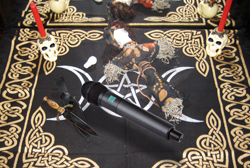When it comes to entertainment wireless systems, it’s not uncommon to hear a wide range of opinions, ideas, “facts” and methodologies about anything from microphone technique to drive racks to damping factor. And quite often, these perceptions are either slightly off-base or are dead wrong.
Having worked in the wireless business for several years now, I’ve heard my share of doozies. Here are some of the more common misconceptions.
1. A directional “paddle” antenna is always needed. Sure, a directional antenna can be a good idea – and even a great one – depending on the application. However, it’s not mentioned often enough that a directional antenna can be best used when the null (the rear) of the antenna is pointed toward an unwanted RF source, such as TV towers, while the live end (the front) is pointed toward the talent.
In this way, the RF signal-to-noise ratio is enhanced. Simply pointing the antennas at talent without considering that the boost realized from the directional pattern may be raising the noise floor right along with your desired signal.
2. Using RF booster amplifiers for the receiver antenna system gives greater operating range. The only reason to use RF boosters in an antenna system is to overcome signal losses in the antenna cables. To determine if boosters are even needed, consider that directional antennas have about 4 dB of passive gain. Using a low-loss cable such as 9913F7 means that even for a 100-foot run, there is only about 3 dB of loss at 600 MHz. Thus, a booster is not needed.
The goal should be to have approximately unity gain between antennas and receivers. Too much boost really is a bad thing for more reason than one. First, receivers are designed to accept no more than a certain signal strength. Too hot of an RF signal can “desensitize” receivers, actually reducing range. Second, simple (passive) is always best in an antenna system if you can manage it. The more gain stages in the receiver system, the more opportunity for unwanted IM (intermod) signal generation.
3. Using a certain brand of battery makes an appreciable difference in range or audio performance. Really? It’s certainly O.K. to be loyal to whatever brand gives you consistent, reliable results. However, nearly all modern transmitters use DC-DC converters so that they will perform in a consistent manner until the batteries die.
Some batteries may last longer than others, but at least for the two major brands (Energizer and Duracell), it’s difficult to measure much of a difference in the real world of actual use.
4. Rechargeable batteries don’t work in wireless mics. Yes, in the old days, NiCad batteries were a horror show. They would develop memories very quickly while rarely developing the voltages of decent alkaline batteries. But the newer technologies are much better. NiMh AA batteries, for instance, are quite good.
Yes, a battery management process needs to be in place if you plan to use rechargeables. That said, these procedures should always be in place for the overall wireless system setup and maintenance anyway.





















